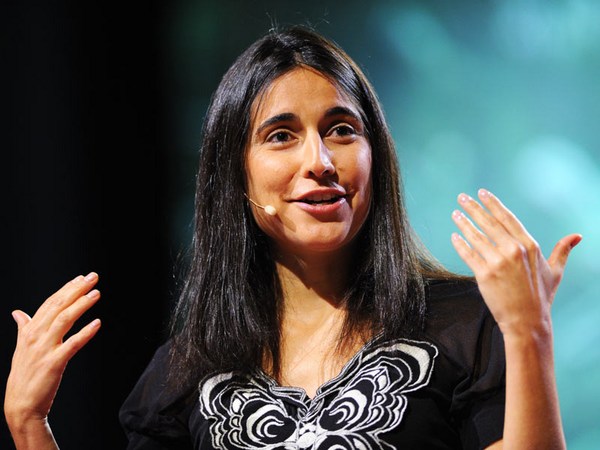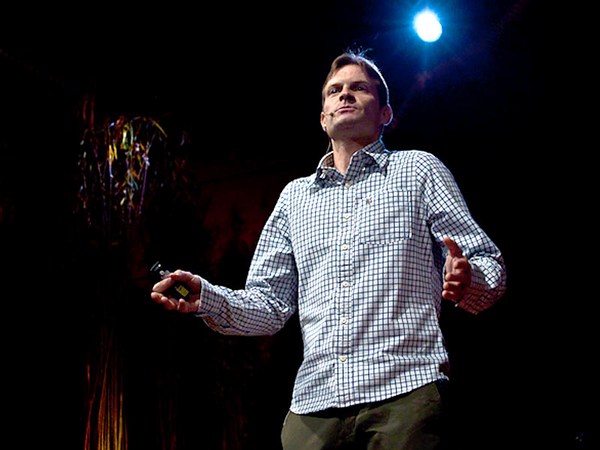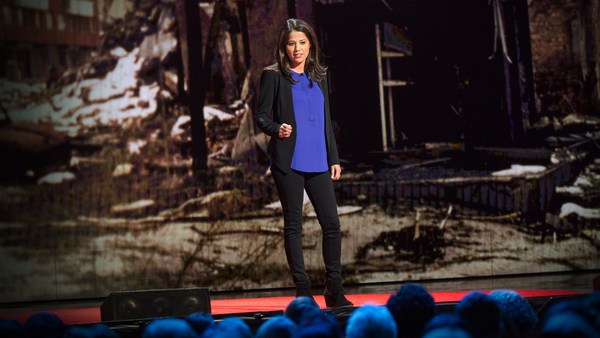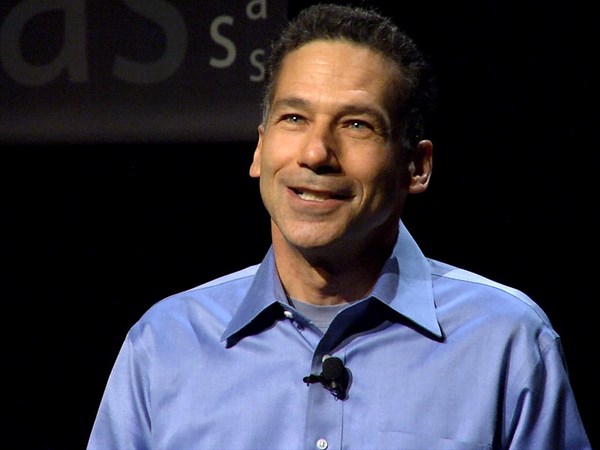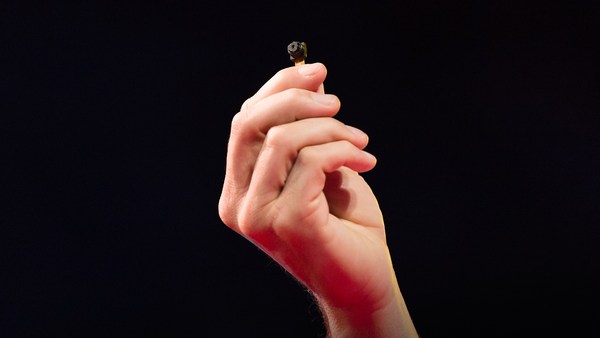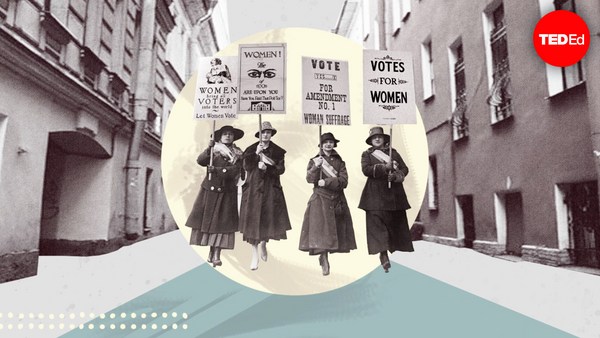Twelve years ago, I picked up a camera for the first time to film the olive harvest in a Palestinian village in the West Bank. I thought I was there to make a single documentary and would then move on to some other part of the world. But something kept bringing me back.
Now, usually, when international audiences hear about that part of the world, they often just want that conflict to go away. The Israeli-Palestinian conflict is bad, and we wish it could just disappear. We feel much the same way about other conflicts around the world. But every time we turn our attention to the news, it seems like one more country has gone up in flames. So I've been wondering whether we should not start looking at conflict in a different way -- whether instead of simply wishing to end conflict, we focus instead on how to wage conflict. This has been a big question for me, one I've pursued together with my team at the nonprofit Just Vision. After witnessing several different kinds of struggles in the Middle East, I started noticing some patterns on the more successful ones. I wondered whether these variables held across cases, and if they did, what lessons we could glean for waging constructive conflict, in Palestine, Israel and elsewhere.
There is some science about this. In a study of 323 major political conflicts from 1900 to 2006, Maria Stephan and Erica Chenoweth found that nonviolent campaigns were almost 100 percent more likely to lead to success than violent campaigns. Nonviolent campaigns are also less likely to cause physical harm to those waging the campaign, as well as their opponents. And, critically, they typically lead to more peaceful and democratic societies. In other words, nonviolent resistance is a more effective and constructive way of waging conflict.
But if that's such an easy choice, why don't more groups use it? Political scientist Victor Asal and colleagues have looked at several factors that shape a political group's choice of tactics. And it turns out that the greatest predictor of a movement's decision to adopt nonviolence or violence is not whether that group is more left-wing or right-wing, not whether the group is more or less influenced by religious beliefs, not whether it's up against a democracy or a dictatorship, and not even the levels of repression that that group is facing. The greatest predictor of a movement's decision to adopt nonviolence is its ideology regarding the role of women in public life.
(Applause)
When a movement includes in its discourse language around gender equality, it increases dramatically the chances it will adopt nonviolence, and thus, the likelihood it will succeed.
The research squared up with my own documentation of political organizing in Israel and Palestine. I've noticed that movements which welcome women into leadership positions, such as the one I documented in a village called Budrus, were much more likely to achieve their goals. This village was under a real threat of being wiped off the map when Israel started building the separation barrier. The proposed route would require the destruction of this community's olive groves, their cemeteries and would ultimately enclose the village from all sides. Through inspired local leadership, they launched a nonviolent resistance campaign to stop that from happening. The odds were massively stacked against them. But they had a secret weapon: a 15-year-old girl who courageously jumped in front of a bulldozer which was about to uproot an olive tree, stopping it. In that moment, the community of Budrus realized what was possible if they welcomed and encouraged women to participate in public life. And so it was that the women of Budrus went to the front lines day after day, using their creativity and acumen to overcome multiple obstacles they faced in a 10-month unarmed struggle. And as you can probably tell at this point, they win at the end.
The separation barrier was changed completely to the internationally recognized green line, and the women of Budrus came to be known across the West Bank for their indomitable energy.
(Applause)
Thank you.
I want to pause for a second, which you helped me do, because I do want to tackle two very serious misunderstandings that could happen at this point. The first one is that I don't believe women are inherently or essentially more peaceful than men. But I do believe that in today's world, women experience power differently. Having had to navigate being in the less powerful position in multiple aspects of their lives, women are often more adept at how to surreptitiously pressure for change against large, powerful actors. The term "manipulative," often charged against women in a derogatory way, reflects a reality in which women have often had to find ways other than direct confrontation to achieve their goals. And finding alternatives to direct confrontation is at the core of nonviolent resistance.
Now to the second potential misunderstanding. I've been talking a lot about my experiences in the Middle East, and some of you might be thinking now that the solution then is for us to educate Muslim and Arab societies to be more inclusive of their women. If we were to do that, they would be more successful. They do not need this kind of help. Women have been part of the most influential movements coming out of the Middle East, but they tend to be invisible to the international community. Our cameras are largely focused on the men who often end up involved in the more confrontational scenes that we find so irresistible in our news cycle. And we end up with a narrative that not only erases women from the struggles in the region but often misrepresents the struggles themselves.
In the late 1980s, an uprising started in Gaza, and quickly spread to the West Bank and East Jerusalem. It came to be known as the First Intifada, and people who have any visual memory of it generally conjure up something like this: Palestinian men throwing rocks at Israeli tanks. The news coverage at the time made it seem like stones, Molotov cocktails and burning tires were the only activities taking place in the Intifada. This period, though, was also marked by widespread nonviolent organizing in the forms of strikes, sit-ins and the creation of parallel institutions.
During the First Intifada, whole sectors of the Palestinian civilian population mobilized, cutting across generations, factions and class lines. They did this through networks of popular committees, and their use of direct action and communal self-help projects challenged Israel's very ability to continue ruling the West Bank and Gaza. According to the Israeli Army itself, 97 percent of activities during the First Intifada were unarmed.
And here's another thing that is not part of our narrative about that time. For 18 months in the Intifada, women were the ones calling the shots behind the scenes: Palestinian women from all walks of life in charge of mobilizing hundreds of thousands of people in a concerted effort to withdraw consent from the occupation. Naela Ayesh, who strived to build a self-sufficient Palestinian economy by encouraging women in Gaza to grow vegetables in their backyards, an activity deemed illegal by the Israeli authorities at that time; Rabeha Diab, who took over decision-making authority for the entire uprising when the men who had been running it were deported; Fatima Al Jaafari, who swallowed leaflets containing the uprising's directives in order to spread them across the territories without getting caught; and Zahira Kamal, who ensured the longevity of the uprising by leading an organization that went from 25 women to 3,000 in a single year. Despite their extraordinary achievements, none of these women have made it into our narrative of the First Intifada.
We do this in other parts of the globe, too. In our history books, for instance, and in our collective consciousness, men are the public faces and spokespersons for the 1960s struggle for racial justice in the United States. But women were also a critical driving force, mobilizing, organizing, taking to the streets. How many of us think of Septima Clark when we think of the United States Civil Rights era? Remarkably few. But she played a crucial role in every phase of the struggle, particularly by emphasizing literacy and education. She's been omitted, ignored, like so many other women who played critical roles in the United States Civil Rights Movement.
This is not about getting credit. It's more profound than that. The stories we tell matter deeply to how we see ourselves, and to how we believe movements are run and how movements are won. The stories we tell about a movement like the First Intifada or the United States Civil Rights era matter deeply and have a critical influence in the choices Palestinians, Americans and people around the world will make next time they encounter an injustice and develop the courage to confront it. If we do not lift up the women who played critical roles in these struggles, we fail to offer up role models to future generations. Without role models, it becomes harder for women to take up their rightful space in public life. And as we saw earlier, one of the most critical variables in determining whether a movement will be successful or not is a movement's ideology regarding the role of women in public life.
This is a question of whether we're moving towards more democratic and peaceful societies. In a world where so much change is happening, and where change is bound to continue at an increasingly faster pace, it is not a question of whether we will face conflict, but rather a question of which stories will shape how we choose to wage conflict.
Thank you.
(Applause)
